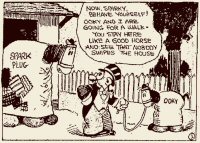Horsefeathers
Q From Theresa B. McKruit: Could you tell me the origin of the word horsefeathers?
A The evidence points strongly to a famous US newspaper cartoon strip.
The issue of American Speech dated December 1928 records that “Mr. William De Beck, the comic-strip comedian responsible for ‘Barney Google,’ assumes credit for the first actual use of the word horsefeathers”. This claim has been frequently reported since, to the point at which it has become accepted knowledge.

Barney Google and Spark Plug,
with Spark Plug’s colt Ooky, in a
strip from 1926. No sign of any
horsefeathers, though.
There’s no doubt Billy De Beck was an early user, since a short comedy film based on his comic strip had the title Horsefeathers, with Barney Hellum as Barney Google and Philip Davis playing Barney’s famous horse Spark Plug. This was doing the rounds in early 1928, so antedating by five years the Marx Brothers film of the same title. De Beck had something of a reputation for coining words and has also been credited with creating, among others, heebie-jeebies, jeepers creepers! and hotsy-totsy. However, so far as I know nobody has actually found the word in a Barney Google strip.
Oddly, the first recorded appearance of the word, in 1927, was in a different comic environment, a cartoon created by T A Dorgen: “The cashier’s department — Bah — Horsefeathers. He wouldn’t give you a ticket to see Halley’s Comet.”
The matter is somewhat confused because of another known sense of the word. Charles Earl Funk, formerly editor-in-chief of the Funk & Wagnalls dictionaries, gave the title Horsefeathers to one of his books on odd words. He told the story in the foreword of having come across it when having his house repaired by an aged master carpenter. On seeking further information from — of all bodies — the National Board of Fire Underwriters, he obtained the following comments:
It refers, as indicated in your letter, to the tapered boards laid on wood shingle roofs to provide a flat surface for asphalt shingles to be laid on in re-roofing. The term “feathering strips,” meaning the same thing, is found in some roofing manuals. The term “horsefeathers” is used colloquially in New England and New York. Its use other than in the slang sense is disappearing and it is only the old-timers who now understand it.
Others have confirmed that this term was indeed at one time in use in the trade, though it is long defunct. One possibility is that it was picked up around 1927 by Billy De Beck or some other writer, who appreciated its comic potential but changed its sense when reproducing it. But my suspicion — based on the early known evidence — is that carpenters around the late 1920s or thereabouts took a word already in existence and applied it to the tapered boards because of the coincidence with the word feathering.
It seems most likely that it began either as a bowdlerised variant of horseshit or as an expression of the view that something is highly unlikely, about as probable as that pigs might fly ... or that horses might have feathers.
